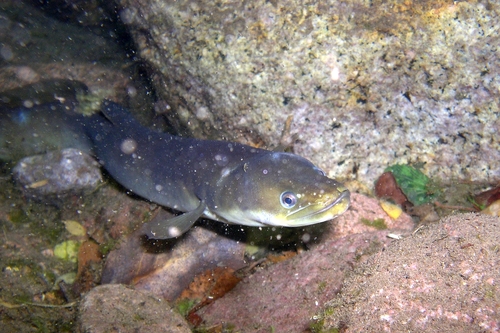
European Eel
The Atlantic bluefin tuna (Thunnus thynnus) is a majestic and highly migratory species of tuna found in the Atlantic Ocean. Renowned for its size, speed, and commercial value, this fish plays a crucial role in marine ecosystems. Its unique physiology and behavior make it a subject of both scientific interest and conservation concern.
15 80 years
Lifespan
60 - 80 cm
Length
Critically Endangered
Conservation Status
5 km/h
Swimming speed
Carnivorous, Omnivorous
Diet
Catadromous Migration
Migration
Appearance Overview
The Atlantic bluefin tuna is renowned for its large, streamlined body, built for speed and endurance in the water.
Color
Dark metallic blue on top with a silvery underside
Fins
Two dorsal fins, the first depressible into a groove; small finlets run down the back and belly to the tail
Body shape
Torpedo-shaped, designed for efficient swimming
Length
Up to 13 feet (4 meters)
Weight
Up to 2,000 lbs (907 kg)
Diet
Carnivorous, feeding on a variety of fish, squid, crustaceans, and occasionally even on kelp.
Feeding Behavior
Highly active predator that uses its speed to chase down prey. They can hunt individually or in groups, sometimes exhibiting coordinated behavior.
Social Behavior
Forms large schools, especially during migration; known for long-distance migrations across oceans.
Commercial Relevance
Extremely high value, especially in sushi and sashimi markets, where its fatty flesh is considered a delicacy.
Conservation measures
Subject to international fishing quotas, monitoring programs, and efforts to reduce bycatch; marine protected areas also play a role.
Status
Endangered
Threats
Historically overfished to near extinction; ongoing threats include illegal fishing, bycatch in other fisheries, and climate change affecting prey distribution.
Habitat Distribution
Depth Range
0-1,000 meters, though they often spend time in surface waters.
Geographic Range
Widely distributed across the North Atlantic Ocean, including the Mediterranean Sea.
Preferred Environment
Prefers temperate and subtropical waters; highly migratory, often crossing entire oceans.
Reproduction and Life Cycle
Breeding Habits
Spawns in two main areas: the Mediterranean Sea and the Gulf of Mexico. Spawning occurs in warm waters during specific seasons.
Development Stages
Eggs hatch into larvae, which are planktonic and drift with currents. Juveniles grow rapidly, feeding voraciously and eventually developing into large adults.
Fecundity
Females can produce a vast number of eggs, up to 30 million per spawning season, depending on their size and condition.
Maturity Age
Reaches sexual maturity relatively late, typically between 4-8 years of age, varying by location and population.
Faqs about European Eel
How long do Atlantic bluefin tuna live?
Atlantic bluefin tuna can live up to 40 years, though this is rare due to fishing pressure.
How fast can Atlantic bluefin tuna swim?
They are among the fastest fish in the ocean, capable of bursts of speed up to 43 mph (70 km/h).
Do Atlantic bluefin tuna migrate?
Yes, they undertake extensive migrations across the Atlantic Ocean for feeding and spawning.
Why are Atlantic bluefin tuna endangered?
Overfishing is the primary reason, driven by high demand in seafood markets.
Are Atlantic bluefin tuna warm-blooded?
They have a specialized vascular system that allows them to maintain a body temperature higher than the surrounding water, aiding in their speed and endurance.
Where do Atlantic Bluefin Tuna spawn?
Major spawning grounds are in the Mediterranean Sea and the Gulf of Mexico.
What do bluefin tuna eat?
Their diet consists of smaller fish like herring and mackerel, squid, and crustaceans.
How do bluefin tuna get so big?
They can reach these immense sizes due to their long lifespan, continuous growth, and energy-rich diet.
Copyright @ Nature Style Limited. All Rights Reserved.
 English
English